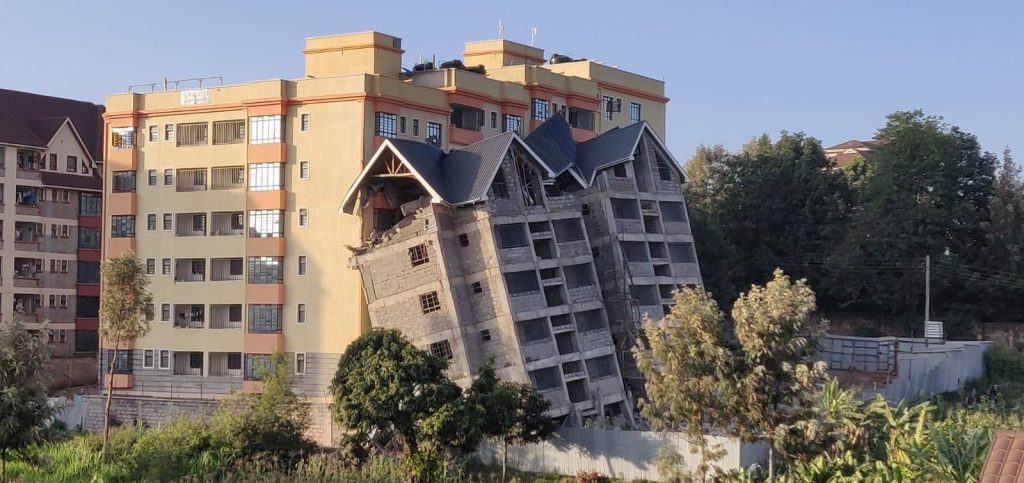“Are you sure it will not come down like that apartment which collapsed?”, asked a client who sought to know whether her multi-storeyed building would come tumbling down, as it has become common in Kenya. It was not just a question of design or assurance, but much more, faultless Architecture. We needed to give more than our word, because of a negative trajectory set by many in the building industry.
The National Construction Authority (NCA), the body tasked with regulating, streamlining, and building capacity in the construction industry, released a report with some astonishing results. They assessed 14,895 buildings, and 10,791 were risky for use and needed further measures taken to make them safe. Only 2,194 were safe. In the last six years, 87 known buildings have collapsed, with over 200 people losing their lives. Therefore, this is a grave issue, demanding critical questions and resolute answers.
The principle strength, i.e., vitality or firmness of a building, is critical and the only aspect of the Vitruvian triad which, if neglected, can lead to devastating, life-ending effects. But the firmitas we are talking about is much more than just strength. As I noted earlier, it involves durability, honest material use, material science, assembly, and the use thereof; a structure well done. For example, a building in a disaster-prone area needs to respond well to the structural requirements, or the finishes in a high traffic public building need to withstand the wear and tear…, etc.
In the earlier days, the architect would be well acquainted with structural knowledge. Until now, architects are sufficiently-trained to make provisions in tandem with what the Civil and Structural engineers will propose and expedite. With the specialization of labour and skill and advanced building technologies, the Civil and Structural Engineer is now a core independent consultant. In addition to making calculations on the structural integrity of a building, he inspects all civil and structural works. They follow the performance of the materials and elements in their designated use. They apply science to give the most optimal design that holds everything in place, yet not extravagant to be brutal on the cost and expression, but well done.

So, why do we still have collapses? We can suggest many reasons. An often left out reason is the disregard for professionals and general apathy for a skilled workforce. As we have recounted earlier in this discourse, the strength of a building is core. So are the professionals who ensure that the structure will not crumble. However, it gets deeper, especially where the professionals themselves are lacking in something critical, i.e., morals and ethics; disregard for the sanctity of life. I will expound on this in a bit.
Understanding how strength, functionality, and beauty correlate with the transcendentals properties of truth, goodness, and beauty is core to appreciating how architecture as a science-art discipline gel together with the objectivity of the former and the subjectivity of the latter. The goal is not to discuss if ugly art can be immoral or unethical but instead to see how this profession which includes the science of engineering and the art of design, is transcendental. As I remarked in my previous article, the definition of the transcendentals by Kenneth Samples is Cosmic values that extend beyond our everyday sensory experiences and are, thus, considered non-physical, immaterial, conceptual, or even spiritual.
Our focus is on strength, which we argue correlates to truth. A building that collapses shows that the designers and builders neglected a vital truth, i.e., the truth about the mathematics of structures, the science of materials, the chemistry of mixtures, or the physics of weights, measures, and time. The transcendental truth is non-physical, immaterial, conceptual, and even spiritual. It transcends everyday sensory experience. In architecture, it becomes what holds everything together; strength. When unprofessionalism results in the loss of human lives, we could blame the weak foundations, poor materials and structural design, unqualified labour, greed, and corruption as the causes. However, if we were to examine, we see the disregard for truth. It certainly is not a one-issue-fixes-all situation but a solution that starts with a basic understanding of life, progressing to the knowledge of engineering and architecture.
We can wait till the next tragedy for the government and its watchdogs to issue threats and more policy guidelines. Or, we can observe and see a society that commissions roads without pedestrian sidewalks or footbridges and leave open unsecured and unmarked excavations. Such a society has no authority to protest against collapsed buildings. It begins with truth in the simple things, for if we addressed these, then my client’s question would not be necessary because things would be well done.
For what is durable is sturdy, and to make anything durable, is to make it well. Until then, the Vitruvian triad collapses on itself, for architecture that is not true cannot be strong. It is unusable because it is not good and can in no way be beautiful.

